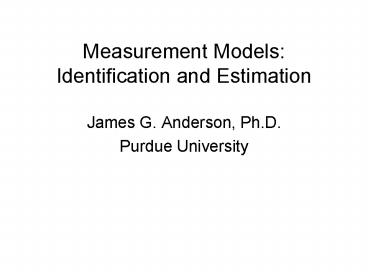Measurement Models: Identification and Estimation - PowerPoint PPT Presentation
1 / 37
Title:
Measurement Models: Identification and Estimation
Description:
Estimates of Md and Mg with Standardized Observed Variables and/or Standardized ... Include the standard errors of the parameter estimates ... – PowerPoint PPT presentation
Number of Views:60
Avg rating:3.0/5.0
Title: Measurement Models: Identification and Estimation
1
Measurement ModelsIdentification and Estimation
- James G. Anderson, Ph.D.
- Purdue University
2
Identification and Estimation
- Identification is concerned with whether the
parameters of the model are uniquely determined. - Estimation involves using sample data to make
estimates of population parameters.
3
(No Transcript)
4
(No Transcript)
5
(No Transcript)
6
(No Transcript)
7
A Confirmatory Factor Analysis Model of
Psychological Disorders
8
Mathematical Specification
9
Mathematical Specification
10
Assumptions
- Each observed variable (X) loads on only one
latent variable - Each observed variable (X) is also affected by a
single residual or unique factor - Curved arrows correspond to correlations among
latent variables - Variances and covariances of the residual factors
are contained in the Theta matrix
11
Conditions for Identification
- Necessary
- Sufficient
- Necessary and Sufficient
12
Degrees of Freedom
13
Degrees of Freedom
14
Models
15
Model A
16
Model B
17
Model C
18
Model D
19
Model E
20
Model F
21
Model G
22
Model H
23
Model Identification
24
Estimation
- Unweighted Least Squares (ULS) Minimizes the
trace or the sum of the diagonal elements of
tr(S-Sigma)2 ULS makes no distributional
assumption so there are no tests of significance.
Also ULS is scale dependent.
25
Estimation
- Generalized Least Squares (GLS) In the fitting
function, differences between S and Sigma are
weighted by elements of S-1 The fitting function
is tr(S-Sigma)S-12 - Maximum Likelihood (ML) minimizes the fitting
function tr(SSigma-1) log lSigmal
- - log lSl q
- If X has a multivariate normal distribution, both
GLS and ML have desirable asymptotic properties.
26
Estimates with Different Constraints
27
Estimation of Model Md with ULS, GLS and ML
28
Model Building
- Models are nested when one model can be obtained
from the other by imposing one or more free
parameters. Therefore, model Mg is nested in Md
and Mg is nested in Mh. - When models are nested, the difference in Chi
Square value is also distributed as Chi Square so
the models can be compared statistically.
29
Comparing the Fit of Nested Models
30
Standardization
- The observed variables (X) can be standardized so
S is a correlation matrix. - The latent variables can be standardized by
constraining the diagonal elements of the phi
matrix to be 1.0.
31
Estimates of Md and Mg with Standardized Observed
Variables and/or Standardized Latent Variables
32
Effects of Standardization
- For Md the decision to analyze the covariance or
correlation matrix or to set the metric by fixing
loadings or variances makes no difference when
scale free estimators such as GLS or ML are used. - For Mg which involves equality constraints,
analyzing the correlation matrix versus the
covariance matrix can have substantive effects on
the results obtained.
33
Improper Solutions
- Nonpositive definite matrices
- Nonconvergence
- Heywood cases
- Improper sign in nonrecursive models
- Binary variables
34
Information to Report on CFA Models
- Model specification
- List the indicators for each factor
- Indicate how the metric of each factor was
defined - Describe all fixed and constrained parameters
- Demonstrate that the model is identified
- Input data
- Description of sample characteristics and size
- Description of the type of data (e.g., nominal,
interval, and scale range of indicators) - Tests of assumptions
- Extent and method of missing data management
- Provide correlations, means, and SDs
35
Information to Report on CFA Models
- Model estimation
- Indicate software and version
- Indicate type of data matrix analyzed
- Indicate estimation method used
- Model evaluation
- Report chi square with df and p value
- Report multiple fit indices (e.g., RMSEA, CFI,
and confidence intervals if applicable) - Report strategies used to assess strains in the
solution (e.g., MIs, standardized residuals) - If model is specified, provide a substantive
rational for added or removed parameters
36
Information to Report on CFA Models
- Parameter estimates
- Provide all parameter estimates (e.g., factor
loadings, error variances, factor variances) - Include the standard errors of the parameter
estimates - Consider the clinical as well as the statistical
significance of the parameter estimates - Substantive conclusions
- Discuss the CFA results in regard to their
substantive implications - Interpret the findings in the context of the
study limitations
37
Reference
- J.S. Long, Confirmatory Factor Analysis, Series
Quantitative Applications in the Social Sciences,
No. 33, Sage publications, 1983.








![Blood Flow Measurement Devices Market Report [2016-2021] PowerPoint PPT Presentation](https://s3.amazonaws.com/images.powershow.com/9400200.th0.jpg?_=20200217018)






















